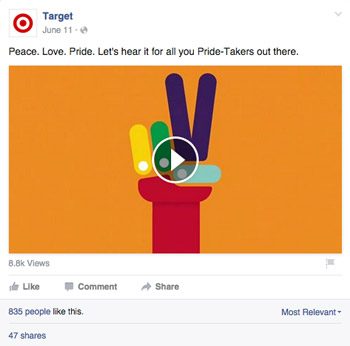Trending topics are a powerful way to engage with audiences in order to build your brand. Leveraging current events and happenings on social media can thrust your brand into the spotlight. Trending topics that are being talked about or shared on Facebook, Instagram, Twitter, Tumblr, Vine, and even Reddit, represent a way to get your say in, to be seen, and to be heard.
If you’re a little clever and creative, you might even pull off going viral or at least be talked about. Who knows? Maybe your brand along with its funny and clever remark or parody video will become the next trending topic! Or, you just might fall flat on your face if you don’t read this article!
Getting your say in on trending topics can help to establish or change your brand’s image, personality, and the associations people have in regards to your brand. Interactivity and engagement are both very powerful in the digital age and the more tactfully you do it, the more favorably your brand will be perceived. This can eventually translate into more conversions and contribute to a positive brand image.
A brand that is active, engaged, and responsive on social media is a brand that is leveraging the powerful outreach opportunities posed by these expansive social networks. Establishing a positive reputation on social media that portrays your brand’s values and ideals is a crucial component of branding, and by relation, conversions.
Unfortunately, too many brands are out of touch with their audiences or don’t even know who their audience is. Yet other times, brands fail to “get” their audience and post cringe-worthy comments or content in futile attempts to engage on social media. Some brands or businesses don’t even engage on social media at all. If your brand doesn’t do it well or at all, you might want to reconsider urgently:

Social signals have become increasingly important to search engine-ranking algorithms. The more buzz, attention, shares, likes, and overall activity you are generating on social media, the better you will rank on search engines.
Learning how to effectively engage the right audience with the right topics represents a great opportunity for brand building and search engine marketing. Getting all 3 right isn’t easy, but keep reading and you’ll discover how straightforward it is with a little thoughtful effort. Here’s the basic formula we’ll be following:
Topic + Audience + Voice = Message.
Topic
- Define Your Topic – The topic is the subject that you decide to engage an audience with. It is the current event or trending topic that you will leverage in an effort to connect with your audience.
Who, what, when, how? The age-old grammatical adage provides a quick method to evaluate if a trending topic is viable for engaging an audience on social media.
- Who or what is the subject of the trending topic? (Relevance)
- When did it happen? (Timeliness)
- How can you leverage that topic to engage an audience? (Method)
There are different kinds of topics that work for different kinds of audiences—and depending on the specific topic, you will engage an audience with a specific voice.
Therefore, the topic is the basis of your engagement and it will ultimately dictate which audience you choose to engage and the voice you will use.
A response to a natural or man-made disaster will certainly differ in tone from one involving a comedic celebrity happening.
Often repeating themes on social media include: celebrity mishaps, comedic instances, critiques, viral videos, political humor and natural or man-made disasters.
Careful consideration must be given when choosing which topics to engage an audience with in order to avoid brand polarization or politicization. This is of course dependent on the image or culture you want your brand to portray. In some cases, brand polarization could be an effective strategy.
For instance, Target decided to remove all gendered-based signs from it stores and posted about it on social media. While it angered some more conservatively minded audiences, it helped to entrench Target as a more progressive and liberal brand with younger audiences.
Finding trending topics can be as easy as keeping an eye on social media, news websites, and news aggregators. And of course, deciding what is ultimately relevant to you and your target audience.
Target does a fantastic job at maintaining a light-hearted yet meaningful social media presence:
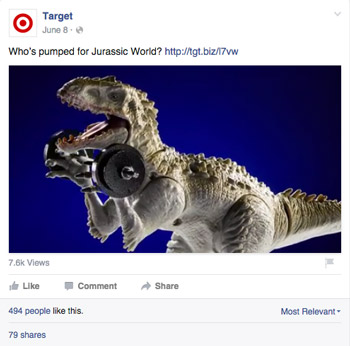
- Pick and Choose – You must be tactical and cautious with which topics you choose to engage an audience with. Sometimes it’s best to stay out of the fray if a topic is controversial and hotly debated.
Other times, it’s best to take a stoic and somber approach to less than great news or events. You don’t have to have something to say in response to everything that is happening in the world, but sometimes, audiences expect something in certain circumstances—especially if it’s relevant to your brand or business.
- Timeliness is Critical – Get your say in at the right time to generate (good) publicity and visibility. If you get your say in too late, you’ll get lost in a sea of noise and kitschiness. You might even be mocked. Look out for my next article on getting the early scoop on trending topics.
Yearly holidays and events make for a great opportunity to engage on social media. Get creative and go beyond just wishing everyone a Happy 4th of July. Funny pictures, videos, or animated gifs go a long way.
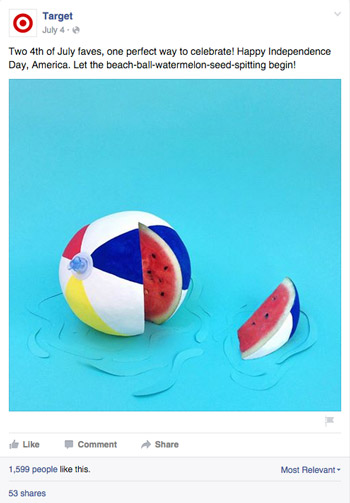
Audience
Who cares about the topic you’re considering to engage an audience with? This is critical. If you can answer this question in detail, then you already know your audience and can move on to the final part of the formula (although you might want to review for good measure).
If you can’t quite put a finger on your audience, then ask yourself a few simple questions to help figure it out:
- Who is the topic or subject relevant to?
- Consider:
- Demographics (age, gender, characteristics)
- Geography (country, region, city)
- Consider:
- Interests (hobbies, movies, TV, music)
- How would an audience feel about it?
- Ask:
- Would they even care?
- Would they find it funny?
- Ask:
- Would they find it offensive or find it in bad taste?
- Which method would you engage that audience with?
- How:
- A clever response or poignant observation?
- A captioned image?
- How:
- A remixed video or animated gif?
If you can’t specifically answer any of these questions, then you might just end up delivering an out-of-touch message to the wrong audience that’ll just think you’re weird. Even if you think you’ve got all these questions figured out, ask for some input from your colleagues and friends; sometimes what you think is hilarious just comes across as crass and irrelevant. Echoing a sentiment that resonates with your audience on a certain subject is the key to effectively engaging with them.
The last thing you generally want to do is become the butt of the joke or lose rep with your customer base. Although even a smart brand manager could leverage those failings and turn them into spectacular comebacks, it’s best to avoid those instances.
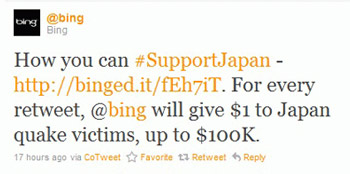
Audiences generally differ on many different levels, but one important thing to consider is the social network you plan to engage an audience on.
Approaching an audience on LinkedIn is vastly different than reaching out to one on Facebook. LinkedIn tends to be more professionally oriented than Facebook, and as such, the topics that you’d want to get your say in on would be different.
The social network is a major consideration when choosing to engage an audience. Keep in mind where the audience is located when deciding which topic you want to engage them with.
Voice
The voice is the tone, style, and language that will be used to engage with your audience. It is dependent on the audience being engaged and on the topic.
A heartfelt offer of condolences will “sound” different than a snarky response to a remark some critic may have made about your brand. Much like a clever comment in response to some funny event will sound different than congratulating someone’s momentous achievement.
So what kind of messages can you use to engage? Questions work well because they naturally elicit responses, especially if they’re thoughtful and targeted. Funny or sarcastic statements can resonate well with younger audiences.
Factual statements can be appropriate in times of critique and criticism against your brand. Ultimately, you’ll have to consider what your objective is when coming up with the kind of message you want to use to engage an audience with.
Messages can also be packaged in several different forms, the most basic of which is simple text. This happens to be most effective on Twitter where one-liners and clever zingers often attract media attention. It can be used with less effect on other social media networks, but since Twitter is largely text-focused, it works best there.
To be more successful, you’ll want to explore other avenues of engagement. Animated gifs, captioned photos, video clips, and any other visually creative mediums that tend to attract more attention. These are a little more time consuming than text, but if you’re finding trending topics early on, you can be ready for the perfect moment to get your say in. When it comes to social media, these platforms require different strategies:
- Facebook – Posting short message with a link to an article or other content, such as an image or short video clip works well. These kinds of statuses can generate a high number of likes, shares, and even spur active discussion. A Facebook audience is likely looking for entertainment or distraction and lesser times information.
- LinkedIn – Posting more valuable content tends to work better. Valuable content is considered to be something that teaches something or informs someone of some facts. An analysis such as one of a highly public marketing fail is the kind of content that tends to work better. A LinkedIn audience is looking for more work or industry-related content, so keep that in mind.
- Twitter – It works best for text-based responses or remarks. Clever or funny responses work well, but you should be very in tune with your audience and careful with crafting your message since it’s mostly text that they will be exposed to and only text can lead to misconstrued messages.
It is important to note the responses to terrible events—whether natural or man-made. Natural disasters need to be carefully considered and responsibility must be assumed. It allows your brand to directly influence and help people who have been, or are going through something terrible. As a brand, you likely have somewhat of an audience on social media that you can leverage in order to do something good.
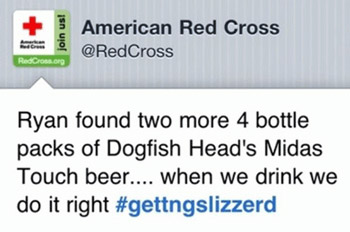
Your message will always differ depending on the topic and audience you’re engaging with. So it’s impossible to offer specific recommendations for engaging with your audience. If you’re having difficulty finding your audience or getting messages across to them, just contact the social media experts at Optimum7.
You won’t always be able to positively engage your audience with trending topics. Some attempts will fail miserably and result in low or the wrong kind of engagement. But the only way to learn (much like everything in marketing) is to test, test, test, until you can figure out what kinds of messages work for your audiences. A savvy brand on social media can boost their search engine rankings, build a loyal following, and attract new customers. If you’re still avoiding social media or not paying much attention to it, now’s the time to start.




